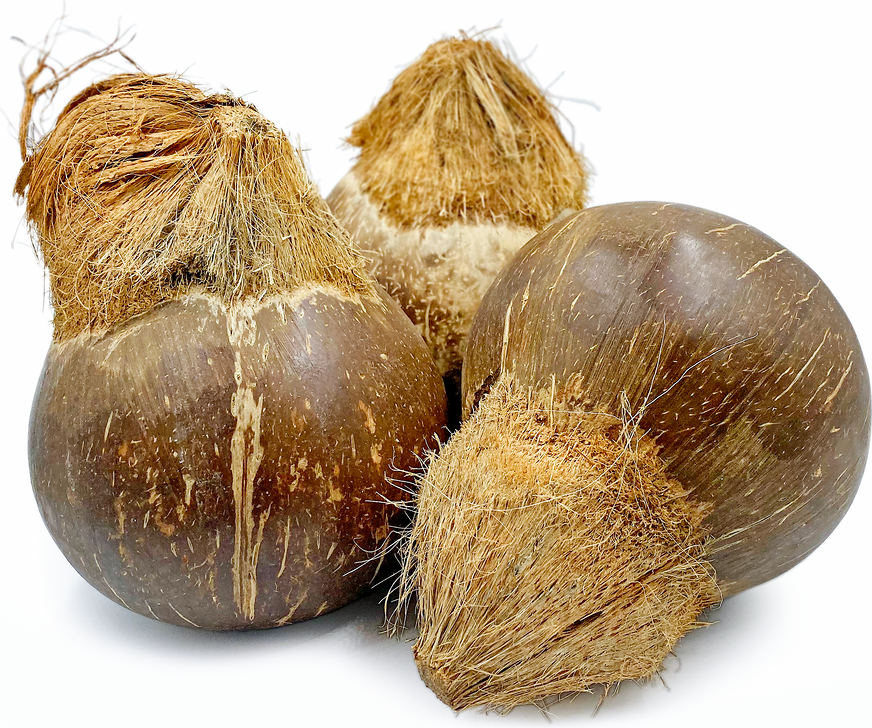


Kappadam Coconut
Estimated Inventory, lb : 0
Description/Taste
Kappadam coconuts average 12 to 15 centimeters in diameter and have a round, ellipsoidal, to oval shape. There is an outer, inedible, and fibrous, tan to light brown husk that surrounds a darker brown, hard shell, and depending on how it is sold, the coconut may have the husk intact, removed, or partially displayed on the top. Underneath the shell, a layer of flesh, also known as the meat, is white, oily, dense, and crisp, encasing a cavity filled with water. As the coconut matures, the water is absorbed, and the flesh grows thicker. When consumed fresh, Kappadam coconuts have a creamy, slippery, and crunchy texture with a rich, tropical, sweet and nutty flavor.
Seasons/Availability
Kappadam coconuts are available year-round in southeast Asia.
Current Facts
Kappadam coconuts, botanically classified as Cocos nucifera, are multi-layered drupes that grow on a tall, slender palm belonging to the Arecaceae or palm family. Coconut palms are native to low-lying, tropical lands with an ample water supply, and Kappadam coconuts are primarily grown on plantations in Thailand and India, utilized locally and exported on a small scale into central Asia and Europe. When exported, the coconuts are considered a specialty item sold through local markets for consumers who value Southeast Asian cuisine and the sweet flavor of the flesh. Kappadam coconuts are marketed at multiple stages of maturity from green, young, and full of water, to mature, hard, and brown, containing high flesh content. Depending on the vendor, the husk may be partially removed, and the shell can be sanded and polished, typically with coconut oil, to give the coconut a pleasing appearance.
Nutritional Value
Kappadam coconuts are an excellent source of copper, fiber, manganese, and fatty acids, which are used for energy and better nutrient absorption. The coconuts also contain potassium, iron, vitamin C, zinc, and folate, and are known to have some antifungal and antibacterial properties.
Applications
Kappadam coconuts are best suited for both raw and cooked applications such as simmering, roasting, and baking. When young, the top of the coconut can be removed, and the water inside the cavity can be consumed. The flesh can also be scooped out with a spoon, and as the coconut matures, the flesh becomes denser with oil. In addition to fresh consumption, Kappadam coconuts can be roasted for a sweeter flavor, and when prepared in this fashion, the flesh is easily removed from the shell by hand. The meat and milk can also be used in many different desserts, including sticky rice, cakes, pies, pudding, and ice cream, and the flesh can be dried for extended use. In southeast Asia, the milk from Kappadam coconuts is popularly incorporated into soups and curries, and the meat can be grated into rice dishes or over cooked meats. Kappadam coconuts pair well with lime, meats such as poultry, pork, beef, and fish, seafood, ginger, fruits such as strawberry, mangoes, citrus, and pineapple, almonds, and chocolate. Fresh, whole coconuts will keep up to four months when stored unopened at room temperature.
Ethnic/Cultural Info
Coconut palms are considered to be one of the most economically important crops grown in the tropics for its versatility as an exportable commodity. Utilized for many different culinary preparations, coconuts such as the Kappadam variety can be consumed fresh, but they are also used to create coconut oil. The oil is pressed from the dried flesh or meat, known as copra, and can be processed and shipped around the world. Coconut oil has become a trending cooking oil in the United States, marketed as a healthy source of saturated fats and as an oil with a long shelf life. Coconuts are also used for their fibers, leaves, and hard shell. The leaves of the palm and the coir fibers from the husk are used to weave baskets and mats, construct ropes, and are utilized as common construction materials. The shells have also become a sustainable material used in making bowls and silverware and are sold worldwide.
Geography/History
Kappadam coconuts are native to tropical, low-lying regions of southeast Asia, specifically to India and Thailand, and have been growing wild since ancient times. In modern-day cultivation, this variety is grown on a smaller scale through small plantations and is used locally and is also exported into central Asia and Europe. The Kappadam coconuts featured in the photograph above were found at the Central Green Market in Almaty, Kazakhstan. While not highly consumed in traditional Kazakh cuisine, a country centered around meat dominant dishes, the coconuts are imported to meet small market demand for tropical produce. Kappadam coconuts are commonly found in Sri Lanka, India, China, and Thailand, and can also be selectively found throughout other regions of Asia and Europe.




